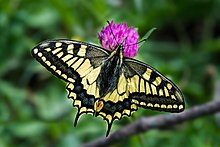| Swallowtail butterfly | |
|---|---|

| |
| Papilio machaon | |
| Scientific classification | |
| Domain: | Eukaryota |
| Kingdom: | Animalia |
| Phylum: | Arthropoda |
| Class: | Insecta |
| Order: | Lepidoptera |
| Superfamily: | Papilionoidea |
| Family: | Papilionidae Latreille, [1802] |
| Type genus | |
| Papilio | |
| Subfamilies and genera | |
|
There are 31 genera and about 600 species:
| |
Swallowtail butterflies are large, colorful butterflies in the family Papilionidae, and include over 550 species. Though the majority are tropical, members of the family inhabit every continent except Antarctica. The family includes the largest butterflies in the world, the birdwing butterflies of the genus Ornithoptera.[1]
Swallowtails have a number of distinctive features; for example, the papilionid caterpillar bears a repugnatorial organ called the osmeterium on its prothorax. The osmeterium normally remains hidden, but when threatened, the larva turns it outward through a transverse dorsal groove by inflating it with fluid.[2]
The forked appearance in some of the swallowtails' hindwings, which can be seen when the butterfly is resting with its wings spread, gave rise to the common name swallowtail. As for its formal name, Linnaeus chose Papilio for the type genus, as papilio is Latin for "butterfly". For the specific epithets of the genus, Linnaeus applied the names of Greek figures to the swallowtails. The type species: Papilio machaon honored Machaon, one of the sons of Asclepius, mentioned in the Iliad.[3] Further, the species Papilio homerus is named after the Greek poet, Homer.[4]
The Mon of the Taira clan of Japan is an Agehachō (swallowtail butterfly).
- ^ Reed, Robert D.; Sperling, Felix A.H. (2006). "Papilionidae – The Swallowtail Butterflies". [Tree of Life Web Project]. Retrieved 7 November 2010.
- ^ Richards, O. W.; Davies, R.G. (1977). Imms' General Textbook of Entomology: Volume 1: Structure, Physiology and Development Volume 2: Classification and Biology. Berlin: Springer. ISBN 0-412-61390-5.
- ^ Salmon, Michael A., Marren, Peter, Harley, Basil. The Aurelian Legacy: British Butterflies and Their Collectors. page 252. Publisher: University of California Press. 2001. ISBN 978-0-520-22963-1
- ^ Lehnert, Matthew S.; Kramer, Valerie R.; Rawlins, John E.; Verdecia, Vanessa; Daniels, Jaret C. (10 July 2017). "Jamaica's Critically Endangered Butterfly: A Review of the Biology and Conservation Status of the Homerus Swallowtail (Papilio (Pterourus) homerus Fabricius)". Insects. 8 (3): 68. doi:10.3390/insects8030068. PMC 5620688. PMID 28698508.